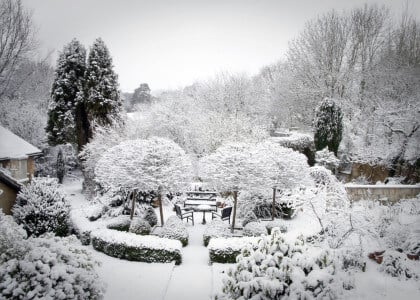Winter is coming so why not learn how to winterize your landscape and plants? Harvests will be coming in, the weather is cooling down, and summer blooms are fading. Now is the time to prepare your garden both for winter, and for spring, when it will burst once again with color and life. Plants are unique and have different specifications for winterizing. Be sure you know them all before the snow comes!
 Pictured: left - Cleveland Select Pear, right - Purple Prince Crabapple
Pictured: left - Cleveland Select Pear, right - Purple Prince Crabapple
Flowering Crabs should be wrapped to protect from rabbits, mice, and sun, and so should Prunus Newport, Schubert Cherry, and fruit trees. Wrapping these varieties will keep them flourishing and in great, healthy condition. Be sure not to wrap them too tight to prevent proper growth. You can purchase tree wrap from your local garden center. Be sure to tape the wrap down with packing tape or duct tape. Make sure you only tape the wrap, not the tree. Plastic tubes can also be used to wrap your tree trunks. Be wary of just using brown or black paper as both will absorb light creating concentrated heat around the young trunk.
 Pictured: Left - Satisfaction Maple, right: Redmond Linden
Pictured: Left - Satisfaction Maple, right: Redmond Linden
Smooth Marked Trees should be wrapped just like your flowering crabs to protect against the scorching sun and subsequent splitting from roasting in the sunlight. Maples, Lindens, and Locusts are especially vulnerable to the sun’s scald. Remove your trees’ wrapping in spring (March or early April) so the bark can harden again.
 Pictured: Left - Colorado Green Spruce, right - Blue Star Juniper, tree form
Pictured: Left - Colorado Green Spruce, right - Blue Star Juniper, tree form
Evergreens should be well-watered until the ground freezes up to assure good health going into winter. This well help the evergreens going into winter as there will then be water available for the evergreens when winter thaws. Once the ground freezes, cease watering.
Newly Planted Evergreens should be protected by a wind/sunscreen. Protecting them can be as simple as covering your young evergreens with burlap. While the burlap won’t be protecting your tree from the cold temperatures, it will serve as a blanket against wind and also keep moisture in at the same time. Stake the burlap to keep it down and around your tree. Most winter damage to evergreens comes from dehydration and drying from the sun and wind. Newly transplanted plants do not yet have an extensive root system to pick up moisture and to replace what is lost. The dehydration makes them more vulnerable to damage over established plants so be sure to continue watering your new evergreens until the soil freezes. Use mulch to help retain moisture around your tree. Breaking the wind and providing some shade can be an easy fix to the problem.
 Pictured: Left - Brevifolia Yew, right - Gold Cargo Arborvitae
Pictured: Left - Brevifolia Yew, right - Gold Cargo Arborvitae
Taxus (Japanese Yew), Hemlocks, and Arborvitae should be protected from deer damage in some areas. If your area has a larger deer population and you find your plants being eaten, small bags (old nylon stocking can be used to make bags) of human hair clippings work well to keep deer away.
 Pictured: Left - Pachysandra, right - Royal Star Magnolia
Pictured: Left - Pachysandra, right - Royal Star Magnolia
Semi-Hardy Plants and Groundcovers in open, sunny areas should be covered with 6-10” of marsh hay after their leaves fall. Keeping the root zone of semi-hardy plants such as Magnolia from alternately freezing and thawing will minimize root injury. That can be done by placing 18-24” of loose material 3’ around the base of the trunk. Be sure to wrap the trunk first with some tree wrap, starting at the base of the trunk and working your way up. Once you’ve wrapped your trees, then cover the ground around them after the ground freezes. Keep in mind that it works better to stabilize the existing frost rather than to attempt to keep it out.
 Pictured: Nearly Wild Floribunda Rose
Pictured: Nearly Wild Floribunda Rose
Hybrid Tea, Floribunda ad Grandiflora Roses must be protected for winter. When the leaves fall, place a 6-8” mound of soil around the canes. After the ground freezes, cover with 13” of marsh hay. In spring, take the hay off and prune them down to 8-10” in early April. Climbing Roses should not be pruned down any further than to where the canes have died back. The soil mound should be removed when soil temperatures are 50 degrees or higher (farmers usually start planting corn at the same temperatures–watch them for timing).
Now that you know how to winterize your landscape and plants for winter, shop our plants online for in-store pickup, local truck delivery, or FedEx.

